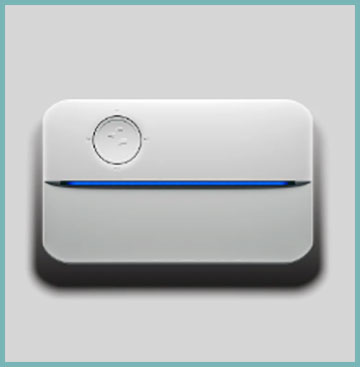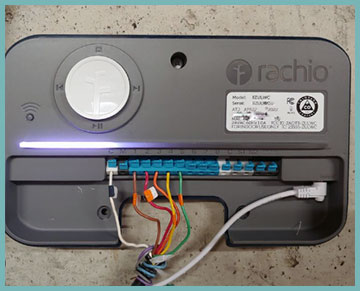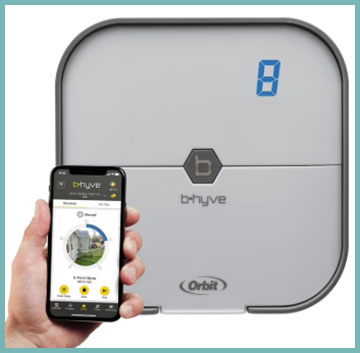As a homeowner passionate about a lush lawn and efficient water use, I’ve spent countless hours researching smart sprinkler controllers to simplify my irrigation routine. The Rachio 3 and Orbit B-Hyve stand out as top contenders, promising app-controlled convenience and water-saving smarts. In this article, I’ll share my journey comparing these two devices, breaking down their features, pros, cons, and my hands-on experience to help you decide which fits your yard best. With a detailed comparison table, maintenance tips, and answers to common questions, you’ll have everything needed to choose wisely.
Comparison Table: Rachio 3 Vs Orbit B-Hyve
| Feature | Rachio 3 | Orbit B-Hyve |
| Price | $150-$250 (4, 8, 16 zones) | $80-$170 (4, 8, 12, 16 zones) |
| Zone Support | 4, 8, 16 zones | 4, 6, 8, 12, 16 zones |
| Smart Home Integration | Alexa, Google Assistant, HomeKit, SmartThings, Nest, IFTTT | Alexa, Google Assistant |
| App Usability | Intuitive, modern, detailed customization | Functional but less organized |
| Weather Technology | Weather Intelligence Plus (rain, wind, freeze skip) | WeatherSense (rain delay, basic weather adjustments) |
| Installation | Easy push-tab wiring, indoor (outdoor with $40 enclosure) | Screw-based wiring, indoor/outdoor (weatherproof case included) |
| Physical Controls | Limited buttons, no display | Buttons, dial, LCD/LED screens |
| Notifications | Start/stop watering, rain skips | End-of-watering only |
| Water Usage Data | Detailed water usage and savings charts | Basic water usage reports |
| Wi-Fi | 2.4GHz and 5GHz | 2.4GHz (XR model: dual-band) |
| Warranty | 2 years | 2 years |
| EPA WaterSense | Yes | Yes |
My Experience With Rachio 3

When I installed my Rachio 3, I was skeptical about its high price tag, but the setup process won me over.
The push-tab wiring was a game-changer—unlike my old controller’s finicky screws, I had everything connected in under 30 minutes.
The app guided me through each step, from Wi-Fi setup to zone configuration, making me feel like a pro despite my limited DIY skills.
Entering details about my lawn’s soil (loamy) and plant types (mostly grass with some shrubs) felt like giving the system a blueprint of my yard.
The app’s interface is where the Rachio 3 shines. I set up custom schedules for my 8-zone system, tailoring watering times to my lawn’s needs.
The Weather Intelligence Plus feature impressed me by skipping watering during a week of unexpected showers, saving me from overwatering. Notifications for when watering starts and stops kept me in the loop, and the water usage charts were oddly satisfying, showing I’d saved over 1,000 gallons in a month.
However, I hit a snag with Wi-Fi connectivity. My garage is a Wi-Fi dead zone, and the Rachio 3 dropped offline twice until I added a $20 extender.
The lack of physical buttons also annoyed me during a brief internet outage—I couldn’t tweak anything without my phone. Despite these hiccups, the Rachio 3’s smarts and ease of use made my lawn care effortless, and I felt confident leaving it to handle my yard while I was on vacation.
Read More: My Thoughts On DuPure Water Softener
Pros Of Rachio 3
- Advanced Weather Intelligence: The Rachio 3’s Weather Intelligence Plus uses local weather data to skip watering during rain, wind, or freezing conditions, ensuring my lawn gets just the right amount of water. It pulls from multiple weather stations, offering precise adjustments.
- Seamless Smart Home Integration: With compatibility across Alexa, Google Assistant, HomeKit, SmartThings, Nest, and IFTTT, I can control my sprinklers through voice commands or integrate them into broader smart home routines, like syncing with my Nest thermostat.
- User-Friendly App: The Rachio app is a standout, with a clean, modern interface that makes scheduling a breeze. I can customize each zone with details like soil type, plant species, and sun exposure, and it provides clear notifications for watering events and skips.
- Detailed Water Usage Insights: The app offers in-depth charts on water usage and savings, helping me track how much water I’m conserving. This feature feels like a financial report for my lawn, showing tangible benefits over time.
- Flexible Zone Options: Available in 4, 8, or 16-zone models, it suits yards of all sizes. I found the 8-zone version perfect for my medium-sized lawn, covering every section without overpaying for unused zones.
- Easy Installation: The push-tab wiring system made setup a snap, taking me under 30 minutes. The app’s guided walkthrough ensured I didn’t miss a step, even as a DIY novice.
- No Subscription Fees: Unlike some competitors, Rachio 3 has no hidden costs. Once purchased, all features are accessible, which is a relief for my budget-conscious self.
The Rachio 3’s robust feature set makes it feel like a premium choice. Its weather smarts and app design give me confidence that my lawn is cared for efficiently, while the lack of a subscription fee keeps costs predictable. Whether I’m tweaking schedules from my phone or letting it auto-adjust for rain, it’s a set-it-and-forget-it solution that aligns with my busy lifestyle.
Cons Of Rachio 3

- Higher Price Point: At $150-$250 depending on zones, it’s pricier than the Orbit B-Hyve. For budget-conscious buyers like me, this initial cost can sting, especially if I need the 16-zone model.
- No Physical Controls: The lack of buttons or a display means I’m reliant on the app or voice control. When my Wi-Fi went down once, I couldn’t adjust settings manually, which was frustrating.
- Indoor-Only Design: Without the $40 outdoor enclosure, it’s not weatherproof. This added cost and the need for an electrical pigtail for outdoor setups felt like an unnecessary hassle compared to Orbit’s all-in-one design.
- Wi-Fi Sensitivity: Some users, including me, noticed occasional Wi-Fi dropouts, requiring a nearby access point for stability. My garage setup needed a Wi-Fi extender to maintain a consistent connection.
- Complex App for Beginners: While I love the app’s depth, its many customization options can overwhelm new users. It took me a couple of days to fully understand zone settings like soil type and slope.
The Rachio 3’s premium price and app dependency might deter some users. If you’re not tech-savvy or prefer manual controls, the lack of a physical interface could be a dealbreaker. Still, its advanced features often outweigh these drawbacks for those willing to invest.
Maintenance Tips For Rachio 3
Keeping my Rachio 3 in top shape is straightforward, but a little care goes a long way to ensure it performs reliably. First, I check the wiring connections every few months, especially after heavy rain or temperature swings, as loose wires can disrupt functionality. The push-tab system is easy to inspect—just pop off the cover and ensure each wire is secure. I also clean the unit’s exterior with a damp cloth to remove dust or debris, particularly if it’s in a dusty garage like mine.
Regular app updates are crucial. I make sure my Rachio app is current to avoid glitches and access new features like improved weather algorithms. The app notifies me of updates, but I check monthly anyway. Wi-Fi stability is another key factor; I placed a Wi-Fi extender near my controller to prevent dropouts, which solved my connectivity issues. If you’re using the outdoor enclosure, inspect it seasonally for cracks or water ingress, as even small leaks can damage the unit.
I also calibrate the weather settings annually. By selecting the closest weather station in the app, I ensure the Weather Intelligence Plus feature accurately skips watering during rain or wind. Lastly, I test each zone manually in spring to confirm sprinkler heads are working, as clogs or leaks can skew the system’s efficiency. These steps keep my Rachio 3 running smoothly, saving water and hassle year-round.
My Experience With Orbit B-Hyve

Installing my Orbit B-Hyve XR was a bit of a chore.
The screw-based wiring felt outdated compared to Rachio’s push-tabs, and I spent nearly 45 minutes wrestling with the connections.
Once set up, though, the app was functional enough to get my 6-zone system running.
I entered details about my lawn’s grass type and sun exposure, and the WeatherSense technology adjusted watering based on local forecasts, pausing during a rainy week.
The app, however, was a mixed bag. It’s not as sleek as Rachio’s, and I struggled to find advanced settings like custom zone schedules. Notifications only came when watering ended, which left me guessing when cycles started. The physical controls were a highlight—during a Wi-Fi outage, I used the buttons and LCD screen to pause watering, a feature Rachio lacks.
The B-Hyve’s affordability was a big win. At $120, it felt like a bargain, and the built-in weatherproof case saved me from buying extras. It’s not perfect, but for my smaller yard, it gets the job done without the premium price. I appreciated the EPA WaterSense certification, which scored me a local rebate, offsetting the cost further.
Pros Of Orbit B-Hyve
- Affordable Price: Priced between $80-$170, the Orbit B-Hyve is a budget-friendly option. I snagged an 8-zone model for $120, a steal compared to Rachio’s $200 for the same zone count.
- Indoor/Outdoor Versatility: The built-in weatherproof case means no extra enclosure is needed for outdoor setups. This saved me time and money, as my controller sits outside without worry.
- Physical Controls: With buttons, a dial, and an LCD/LED display (XR model), I can adjust settings without my phone. This was a lifesaver when my Wi-Fi went out during a storm.
- WeatherSense Technology: It uses local weather data to adjust watering, pausing for rain or high winds. While not as advanced as Rachio’s, it still kept my lawn from getting soggy during rainy weeks.
- Zone Flexibility: Available in 4, 6, 8, 12, or 16-zone models, it fits various yard sizes. My 6-zone system covered my lawn and garden beds perfectly.
- EPA WaterSense Certified: Like Rachio, it qualifies for water bill rebates in some areas, which I took advantage of through my local water district, saving $50.
- Dual-Band Wi-Fi (XR Model): The XR model supports both 2.4GHz and 5GHz Wi-Fi, offering better connectivity in crowded networks. My XR unit stayed online consistently.
The Orbit B-Hyve delivers solid value for the price. Its physical controls and weatherproof design make it practical, while the app provides enough smarts for most homeowners. It’s a great pick if you want smart features without breaking the bank.
Cons Of Orbit B-Hyve
- Clunky App Interface: The B-Hyve app feels less polished than Rachio’s, with a cluttered layout that took me longer to navigate. Setting up custom schedules was less intuitive, often requiring trial and error.
- Limited Smart Home Integration: It only works with Alexa and Google Assistant, lacking HomeKit or IFTTT support. I couldn’t integrate it with my SmartThings hub, which was a letdown.
- Basic Weather Adjustments: WeatherSense is less sophisticated than Rachio’s Weather Intelligence Plus, missing features like wind or freeze skips. It once watered during a windy day, wasting water.
- Screw-Based Wiring: Installation was trickier due to the screw-based wiring system, which required more force and precision. It took me 45 minutes compared to Rachio’s quick setup.
- Limited Notifications: The app only notifies when watering ends, not when it starts. This made it harder to monitor real-time activity, especially when I was away.
The Orbit B-Hyve’s budget-friendly price comes with trade-offs. The app’s clunkiness and limited integrations frustrated me at times, and the weather features aren’t as precise. It’s a solid choice for basic needs but lacks the polish of Rachio.
Maintenance Tips For Orbit B-Hyve
Maintaining my Orbit B-Hyve is simple but requires consistent attention to keep it reliable. I start by checking the screw-based wiring every season, as vibrations or weather can loosen connections. Using a small screwdriver, I tighten each screw to ensure a firm grip, which prevents misfires. The weatherproof case is durable, but I inspect it for cracks or debris buildup, especially after storms, and wipe it down with a damp cloth.
Updating the B-Hyve app is essential for bug fixes and improved weather data accuracy. I check for updates monthly, as older versions caused scheduling glitches for me once. The XR model’s LED displays can accumulate dust, so I gently clean them with a dry cloth to keep them readable. For outdoor units, I ensure the controller is shaded to avoid overheating, which can affect performance.
I also test my rain sensor annually, as it’s critical for WeatherSense to skip watering during rain. If it’s malfunctioning, I replace it with an Orbit-compatible sensor to maintain accuracy. Finally, I run a manual test of each zone in spring to spot sprinkler head issues, ensuring the system waters efficiently. These steps keep my B-Hyve running smoothly, saving water and effort.
Read More: My Thoughts On Waterboss Proplus 380
Frequently Asked Questions (FAQ)
No, the Rachio 3 is still actively sold and supported as of July 2025, with no official discontinuation announced.
Rachio 3 remains a top choice for its advanced features and app, but Orbit B-Hyve is a strong contender for budget-conscious users.
Rachio leads for premium features and integrations, while Orbit excels in affordability and physical controls. It depends on your needs.
No, Rachio 3 has no monthly fees; all features are included with the purchase.
Conclusion: Rachio 3 Vs Orbit B-Hyve
Choosing between the Rachio 3 and Orbit B-Hyve depends on what you value most for your yard. If you’re after a premium experience with a slick app, robust smart home integrations, and precise weather adjustments, the Rachio 3 is worth the higher price. Its detailed water usage insights and easy installation made my lawn care effortless, though the Wi-Fi sensitivity and lack of physical controls were minor frustrations. If budget is your priority, the Orbit B-Hyve offers great value with its weatherproof design and physical controls, perfect for hands-on users. Despite its clunky app, it’s reliable for basic smart watering. Weigh your needs—Rachio for sophistication, Orbit for affordability—and you’ll find the perfect fit.
